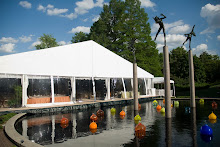Wednesday, September 14, 2011
Limitations of Your Tent Rental
Tents and structures are excellent alternatives to traditional event spaces and have limitless industrial, agricultural, commercial, and construction applications. Tents do come with some limitations. One of the most common misconceptions about tents is that they will protect your event or application regardless of what mother nature brings our way. Tents can protect you from the rain overhead, but do not prevent the water from running underneath the tent and saturating the ground, your guests feet, or anything being stored inside. This risk can be mitigated by installing an elevated floor under your tent. This will allow the water run under the floor keeping your space dry. In permanent or long term installations it may make sense to pour a concrete or asphalt pad. Tents also have a limited capacity to withstand high winds. The majority of tents from rental companies are traditional frame tents and pole tents. These tents typically do not come with any engineering to meet specific wind loads. The exceptions to this rule are clearspan tents and tension tents. Most clearspans are engineered to withstand 3 second bursts at 90 MPH and 70 MPH constant load. Tension tents are typically engineered between 70 and 90 MPH depending upon manufacturer and model of tent purchased. Be sure to check with your rental provider to see what type of tent you are getting and to ensure it will meet your needs. The single largest factor when considering your tent provider is the quality of the installation. An engineered structure that is not installed and anchored properly will not perform when put to the test. Take a long look at the company's history, experience, and speak with some past clients to help ensure you will get a quality installation with a reputable tent company.
Subscribe to:
Post Comments (Atom)


No comments:
Post a Comment